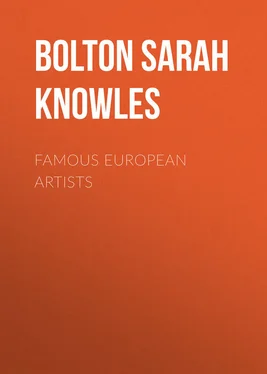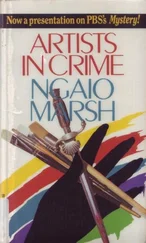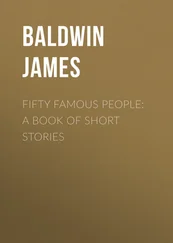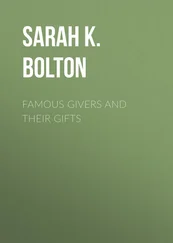Sarah Bolton - Famous European Artists
Здесь есть возможность читать онлайн «Sarah Bolton - Famous European Artists» — ознакомительный отрывок электронной книги совершенно бесплатно, а после прочтения отрывка купить полную версию. В некоторых случаях можно слушать аудио, скачать через торрент в формате fb2 и присутствует краткое содержание. ISBN: , Жанр: foreign_prose, foreign_antique, foreign_language, на английском языке. Описание произведения, (предисловие) а так же отзывы посетителей доступны на портале библиотеки ЛибКат.
- Название:Famous European Artists
- Автор:
- Жанр:
- Год:неизвестен
- ISBN:http://www.gutenberg.org/ebooks/39380
- Рейтинг книги:5 / 5. Голосов: 1
-
Избранное:Добавить в избранное
- Отзывы:
-
Ваша оценка:
- 100
- 1
- 2
- 3
- 4
- 5
Famous European Artists: краткое содержание, описание и аннотация
Предлагаем к чтению аннотацию, описание, краткое содержание или предисловие (зависит от того, что написал сам автор книги «Famous European Artists»). Если вы не нашли необходимую информацию о книге — напишите в комментариях, мы постараемся отыскать её.
Famous European Artists — читать онлайн ознакомительный отрывок
Ниже представлен текст книги, разбитый по страницам. Система сохранения места последней прочитанной страницы, позволяет с удобством читать онлайн бесплатно книгу «Famous European Artists», без необходимости каждый раз заново искать на чём Вы остановились. Поставьте закладку, и сможете в любой момент перейти на страницу, на которой закончили чтение.
Интервал:
Закладка:
When the marble reached Rome, the people were astonished, for there seemed enough to build a temple, instead of a tomb. The sculptor resided in a house near the Vatican, a covered way being constructed by the pope between the atelier and the palace, that he might visit the artist familiarly and see him at his work.
Meantime an envious artist was whispering in the ears of Julius that it was an evil omen to build one's monument in one's lifetime, and that he would be apt to die early. This was not agreeable news, and when Michael Angelo returned from a second journey to Carrara the pope refused to advance any money, and even gave orders that he should not be admitted to the palace.
With commendable pride the artist left Rome at once, and hastened to Florence, leaving a letter in which he said, "Most Holy Father, – If you require me in the future, you can seek me elsewhere than in Rome."
The proud Julius at once perceived his mistake, and sent a messenger to bid him return, on pain of his displeasure. But Michael Angelo paid no attention to the mandate. Then Julius II. applied to Soderini the Gonfaloniere, who said to the sculptor, "You have treated the pope in a manner such as the King of France would not have done! There must be an end of trifling with him now. We will not for your sake begin a war with the pope, and risk the safety of the state."
The Sultan Bajazet II., who had heard of Michael Angelo's fame, now urged him to come to Turkey and build a bridge between Constantinople and Pera, across the Golden Horn. Soderini tried to persuade him that he had better "die siding with the pope, than live passing over to the Turk," and meantime wrote Julius that he could do nothing with him. The pope saw that kindness alone would win back the self-reliant and independent artist, and finally prevailed upon him to return to Rome.
When he arrived, Julius, half angry, said, "You have waited thus long, it seems, till we should ourselves come to seek you."
An ecclesiastic standing near officiously begged his Holiness not to be too severe with Michael Angelo, as he was a man of no education, and as artists did not know how to behave except where their own art was concerned.
The pope was now fully angry, and exclaimed, "Do you venture to say things to this man which I would not have said to him myself? You are yourself a man of no education, a miserable fellow, and this he is not. Leave our presence." The man was borne out of the hall, nearly fainting.
Michael Angelo was at once commissioned to make a bronze statue of Julius, fourteen feet high, to be placed before the Church of St. Petronio, in Bologna. When the pope wished to know the cost, the artist told him he thought it would be about three thousand ducats, but was not sure whether the cast would succeed.
"You will mould it until it succeeds," said the pope, "and you shall be paid as much as you require."
When the clay model was ready for the pope to look at, he was asked if he would like to be represented holding a book in his left hand.
"Give me a sword!" he exclaimed; "I am no scholar. And what does the raised right hand denote? Am I dispensing a curse, or a blessing?"
"You are advising the people of Bologna to be wise," replied Michael Angelo.
The bronze statue was a difficult work. The first cast was unsuccessful. The sculptor wrote home, "If I had a second time to undertake this intense work, which gives me no rest night or day, I scarcely think I should be able to accomplish it. I am convinced that no one else upon whom this immense task might have been imposed would have persevered. My belief is that your prayers have kept me sustained and well. For no one in Bologna, not even after the successful issue of the cast, thought that I should finish the statue satisfactorily; before that no one thought that the cast would succeed."
After the statue was completed, Michael Angelo, at the earnest request of the helpless Buonarotti family, went back to Florence, and carried there what he had earned. Grimm naïvely remarks, "I could almost suppose that it had been designed by Fate, as may be often observed in similar cases, to compensate for Michael Angelo's extraordinary gifts by a corresponding lack of them in the family." The case of Galileo, struggling through life for helpless relatives, is similar to that of Michael Angelo.
He was soon summoned again to Rome, not to complete the monument, as he had hoped, but to paint the ceiling of the Sistine Chapel. He hesitated to undertake so important a work in painting, and begged that Raphael be chosen; but the pope would not consent.
He therefore began to make designs, and sent for some of his boyhood friends to aid him, Granacci and others. His method was to make the first draught in red or black chalk on a very small scale. From this he marked out the full-sized cartoons or working drawings, nailing these to the wall, and cutting away the paper around the figures. He soon found that his assistants were a hinderance rather than a help, and, unable to wound their feelings by telling them, he shut up the chapel and went away. They understood it, and, if some were hurt or offended, Granacci was not, but always remained an earnest friend.
Michael Angelo now worked alone, seeing nobody except his color-grinder and the pope. His eyes became so injured by holding his head back for his work that for a long period afterwards he could read only by keeping the page above his head. After he had painted for some time the walls began to mould, and, discouraged, he hastened to the pope, saying, "I told your Holiness, from the first, that painting was not my profession; all that I have painted is destroyed. If you do not believe it, send and let some one else see." It was soon found that he had made the plaster too wet, but that no harm would result.
He worked now so constantly that he scarcely took time to eat or sleep, and became ill from overexertion. In the midst of his labors and illness, he writes his father, "Do not lose courage, and let not a trace of inward sadness gain ground in you; for, if you have lost your property, life is not lost, and I will do more for you than all you have lost. Still, do not rely upon it; it is always a doubtful matter. Use, rather, all possible precaution; and thank God that, as this chastisement of heaven was to come, it came at a time when you could better extricate yourself from it than you would perhaps have been earlier able to do. Take care of your health, and rather part with all your possessions than impose privations on yourself. For it is of greater consequence to me that you should remain alive, although a poor man, than that you should perish for the sake of all the money in the world.
Your Michael Angelo."
He writes also to his younger brother, Giovanni Simone, who appears to have spent much and earned little: "If you will take care to do well, and to honor and revere your father, I will aid you like the others and will soon establish you in a good shop… I have gone about through all Italy for twelve years, leading a dog's life; bearing all manner of insults, enduring all sorts of drudgery, lacerating my body with many toils, placing my life itself under a thousand perils, solely to aid my family; and now that I have commenced to raise it up a little, thou alone wishest to do that which shall confound and ruin in an hour everything that I have done in so many years and with so many fatigues."
Meantime the pope, as eager as a child to see the painting which he knew would help to immortalize himself, urged the artist to work faster, and continually asked when it would be finished and the scaffolding taken down. "When I can, holy father," replied the artist. "When I can – when I can! I'll make thee finish it, and quickly, as thou shalt see!" And he struck Michael Angelo with the staff which he held in his hand.
Читать дальшеИнтервал:
Закладка:
Похожие книги на «Famous European Artists»
Представляем Вашему вниманию похожие книги на «Famous European Artists» списком для выбора. Мы отобрали схожую по названию и смыслу литературу в надежде предоставить читателям больше вариантов отыскать новые, интересные, ещё непрочитанные произведения.
Обсуждение, отзывы о книге «Famous European Artists» и просто собственные мнения читателей. Оставьте ваши комментарии, напишите, что Вы думаете о произведении, его смысле или главных героях. Укажите что конкретно понравилось, а что нет, и почему Вы так считаете.












